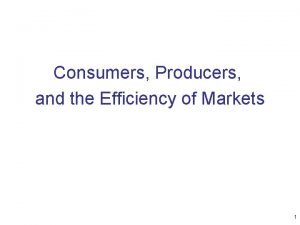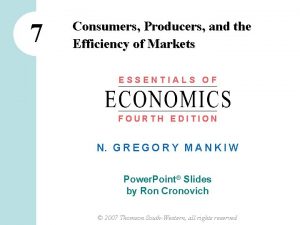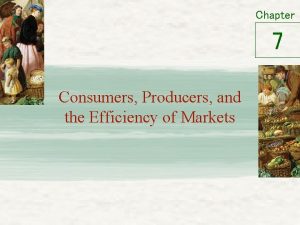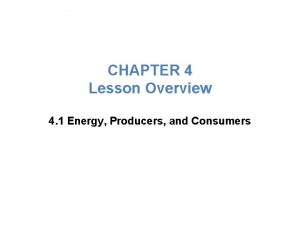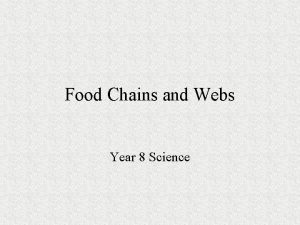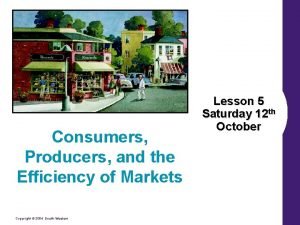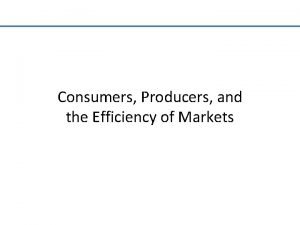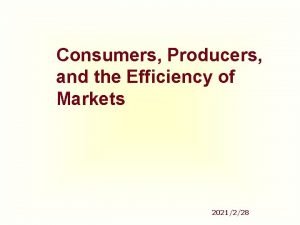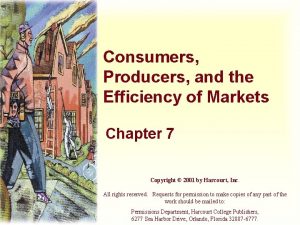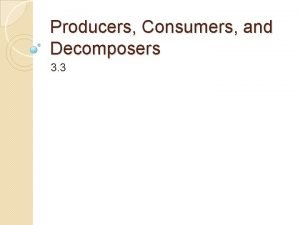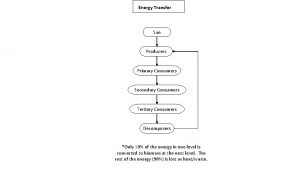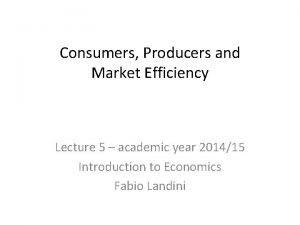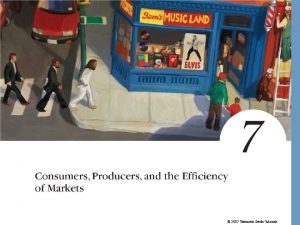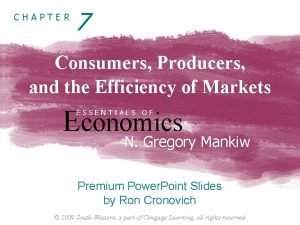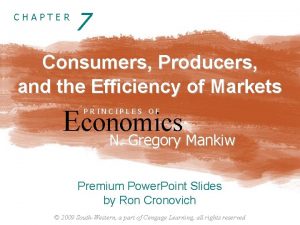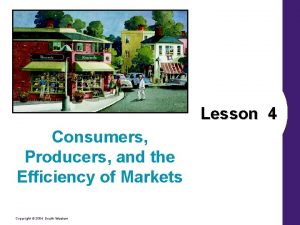Consumers producers and the efficiency of markets Do






























- Slides: 30

Consumers, producers, and the efficiency of markets • Do the equilibrium price and quantity maximize the total welfare of buyers and sellers? • Market equilibrium reflects the way markets allocate scarce resources. • Whether the market allocation is desirable can be addressed by welfare economics.

Welfare Economics • Welfare economics is the study of how the allocation of resources affects economic wellbeing. • Buyers and sellers receive benefits from taking part in the market. • The equilibrium in a market maximizes the total welfare of buyers and sellers.

Welfare Economics • Equilibrium in the market results in maximum benefits, and therefore maximum total welfare for both the consumers and the producers of the product. • Consumer surplus measures economic welfare from the buyer’s side. • Producer surplus measures economic welfare from the seller’s side.

CONSUMER SURPLUS • Willingness to pay is the maximum amount that a buyer will pay for a good. • It measures how much the buyer values the good or service. • Consumer surplus is the buyer’s willingness to pay for a good minus the amount the buyer actually pays for it.

Four Possible Buyers’ Willingness to Pay

CONSUMER SURPLUS • The market demand curve depicts the various quantities that buyers would be willing and able to purchase at different prices.

The Demand Schedule and the Demand Curve

Figure 1 The Demand Schedule and the Demand Curve Price of Album John’s willingness to pay $100 Paul’s willingness to pay 80 George’s willingness to pay 70 Ringo’s willingness to pay 50 Demand 0 1 2 3 4 Quantity of Albums

Figure 2 Measuring Consumer Surplus with the Demand Curve (b) Price = $70 Price of Album $100 John’s consumer surplus ($30) 80 Paul’s consumer surplus ($10) 70 50 Total consumer surplus ($40) Demand 0 1 2 3 4 Quantity of Albums

Using the Demand Curve to Measure Consumer Surplus • The area below the demand curve and above the price measures the consumer surplus in the market.

Figure 3 How the Price Affects Consumer Surplus (a) Consumer Surplus at Price P Price A Consumer surplus P 1 B C Demand 0 Q 1 Quantity

Figure 3 How the Price Affects Consumer Surplus (b) Consumer Surplus at Price P Price A Initial consumer surplus P 1 P 2 0 C B Consumer surplus to new consumers F D E Additional consumer surplus to initial consumers Q 1 Demand Q 2 Quantity

What Does Consumer Surplus Measure? • Consumer surplus, the amount that buyers are willing to pay for a good minus the amount they actually pay for it, measures the benefit that buyers receive from a good as the buyers themselves perceive it.

PRODUCER SURPLUS • Producer surplus is the amount a seller is paid for a good minus the seller’s cost. • It measures the benefit to sellers participating in a market.

Table 2 The Costs of Four Possible Sellers

Using the Supply Curve to Measure Producer Surplus • Just as consumer surplus is related to the demand curve, producer surplus is closely related to the supply curve.

The Supply Schedule and the Supply Curve

Figure 4 The Supply Schedule and the Supply Curve

Using the Supply Curve to Measure Producer Surplus • The area below the price and above the supply curve measures the producer surplus in a market.

Figure 5 Measuring Producer Surplus with the Supply Curve (b) Price = $800 Price of House Painting $900 Supply Total producer surplus ($500) 800 600 Georgia’s producer surplus ($200) 500 Grandma’s producer surplus ($300) 0 1 2 3 4 Quantity of Houses Painted

Figure 6 How the Price Affects Producer Surplus (a) Producer Surplus at Price P Price Supply P 1 B Producer surplus C A 0 Q 1 Quantity

Figure 6 How the Price Affects Producer Surplus (b) Producer Surplus at Price P Price Supply Additional producer surplus to initial producers P 2 P 1 D E F B Initial producer surplus C Producer surplus to new producers A 0 Q 1 Q 2 Quantity

MARKET EFFICIENCY • Consumer surplus and producer surplus may be used to address the following question: • Is the allocation of resources determined by free markets in any way desirable? Consumer Surplus = Value to buyers – Amount paid by buyers and Producer Surplus = Amount received by sellers – Cost to sellers

MARKET EFFICIENCY Total surplus = Consumer surplus + Producer surplus or Total surplus = Value to buyers – Cost to sellers • Efficiency is the property of a resource allocation of maximizing the total surplus received by all members of society. • In addition to market efficiency, a social planner might also care about equity – the fairness of the distribution of well-being among the various buyers and sellers.

Figure 7 Consumer and Producer Surplus in the Market Equilibrium Price A D Supply Consumer surplus Equilibrium price E Producer surplus B Demand C 0 Equilibrium quantity Quantity

MARKET EFFICIENCY • Three Insights Concerning Market Outcomes • Free markets allocate the supply of goods to the buyers who value them most highly, as measured by their willingness to pay. • Free markets allocate the demand for goods to the sellers who can produce them at least cost. • Free markets produce the quantity of goods that maximizes the sum of consumer and producer surplus.

Figure 8 The Efficiency of the Equilibrium Quantity Price Supply Cost to sellers Value to buyers Cost to sellers 0 Value to buyers Equilibrium quantity Value to buyers is greater than cost to sellers. Value to buyers is less than cost to sellers. Demand Quantity

Evaluating the Market Equilibrium • Because the equilibrium outcome is an efficient allocation of resources, the social planner can leave the market outcome as he/she finds it. • This policy of leaving well enough alone goes by the French expression laissez faire.

Evaluating the Market Equilibrium • Market Power • If a market system is not perfectly competitive, market power may result. • Market power is the ability to influence prices. • Market power can cause markets to be inefficient because it keeps price and quantity from the equilibrium of supply and demand.

Evaluating the Market Equilibrium • Externalities • created when a market outcome affects individuals other than buyers and sellers in that market. • cause welfare in a market to depend on more than just the value to the buyers and cost to the sellers. • When buyers and sellers do not take externalities into account when deciding how much to consume and produce, the equilibrium in the market can be inefficient.
 Consumers, producers, and the efficiency of markets
Consumers, producers, and the efficiency of markets Consumers producers and the efficiency of markets
Consumers producers and the efficiency of markets Chapter 7 consumers producers and the efficiency of markets
Chapter 7 consumers producers and the efficiency of markets Food chain
Food chain Producers primary consumers secondary consumers
Producers primary consumers secondary consumers Producer decomposer consumer
Producer decomposer consumer Consumers producers and decomposers are all
Consumers producers and decomposers are all Is a horse a producer consumer or decomposer
Is a horse a producer consumer or decomposer What are 3 producers
What are 3 producers Chapter 4 lesson 1 energy, producers and consumers
Chapter 4 lesson 1 energy, producers and consumers Food chain with a producer and 3 consumers
Food chain with a producer and 3 consumers What is a decomposer in a food chain
What is a decomposer in a food chain Energy producers and consumers lesson 1
Energy producers and consumers lesson 1 Decomposer
Decomposer Jungle food chains
Jungle food chains Anemone producers consumers and decomposers
Anemone producers consumers and decomposers Ant food chain
Ant food chain Tertiary consumers in the rainforest
Tertiary consumers in the rainforest Tertiary food web
Tertiary food web Organizational buyer
Organizational buyer Producers consumers decomposers
Producers consumers decomposers Biotic components producers consumers decomposers
Biotic components producers consumers decomposers Producers respond to consumers' positive economic votes by
Producers respond to consumers' positive economic votes by Are brine flies producers or consumers
Are brine flies producers or consumers Creating products for consumers in global markets
Creating products for consumers in global markets Allocative efficiency vs productive efficiency
Allocative efficiency vs productive efficiency Allocative efficiency vs productive efficiency
Allocative efficiency vs productive efficiency Allocative efficiency vs productive efficiency
Allocative efficiency vs productive efficiency Weasels food chain
Weasels food chain Is seaweed a primary producer
Is seaweed a primary producer Hát kết hợp bộ gõ cơ thể
Hát kết hợp bộ gõ cơ thể
